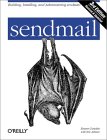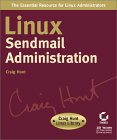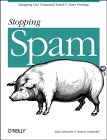Open Source:
- MTA's:
- Postfix - Fast and secure - Wietse Venema's mailer (son of VMailer and IBM Secure Mailer)
- VMware: Zimbra - Based on Postfix MTA, includes AJAX based web mail and calendering, antispan, search, backup, archiving, .... Built on top of Tomcat, MySQL, JAVA, Apache, Lucene, ClamAV, SpamAssassin, OpenLDAP and of course Postfix technologies. [Zimbra suite] It rocks.
- Sendmail
- controlled relay
- Anti-relay - (Debugging check_*)
- SMTP authentication AUTH/SASL
- Installation and Operation guide (pdf)
- Sendmail configuration files
- Exim - University of Cambridge (son of Smail)
- QMail
- Life with qmail
- qmail-ldap - Central LDAP authentication for large user databases.
- QMail Anti-Spam HOWTO
- Postfix - Fast and secure - Wietse Venema's mailer (son of VMailer and IBM Secure Mailer)
- Integrated Mail and Calendaring:
Commercial MTA's:
- Axigen: eMail server, anti-virus, anti-spam, web mail, backup/restore.
- Novell/S.U.S.E. Linux Openexchange Server (SLOX) - Postfix, IMAP and LDAP configured for use with MS/Outlook (See the YoLinux LDAP tutorial and see how to do it for free.) Supports MAPI (Messaging Application Programming Interface) clients and SIP. Third party support for anti-virus and anti-spam. Also POP3, IMAP4 support.
- IBM: Lotus Notes Domino Mail Server - E-mail, Web access, Calendaring and Scheduling, bulletin boards, newsgroups, mobile support
- Gordano - Messaging, Calendaring, Webmail, MAPI, anti-virus and anti-SPAM. Also POP3, IMAP4 support.
- Sendmail.com - commercial version of sendmail
- Scalix - Messaging, Webmail, MAPI. Third party support for anti-virus and anti-spam. Also POP3, IMAP4 support.
- Stalker software: CommuniGate Pro - Features anti-Spam, clustering, web admin, web mail, multi-domain, Mail lists, LDAP, ACAP, SSL, CLL, SASL, anti-virus, IM, MAPI, POP3, IMAP4
- Axigen mail server - SMTP, POP3, IMAP4, WebMail, List Server SSL/TLS, SPF, antivirus and antispam support
MTA Server support software:
- OpenGroupWare.org - Was SKYRIX groupware server, then OGo. Piggybacks on an existing SMTP server to handle mail but then provides calendar groupware and mail interface with email clients. Uses WEBDAV interface protocol.
- RFC2505 - Anti Spam
- OpenRBL.org - Blackhole List and lookup
- Mail-Abuse.org: MAPS - Mail Abuse Prevention System
- CAUCE International - Coalition Against Unsolicited Commercial Email
- The SPAM-L FAQ
- SpamCop.net - Database and anti-spam services.
- How to sue an email spammer in small claims court and win money - by Ben Livingston
- SpamMap - Relationships between spammers and commerce sites mapped out in a chart.
- SpamHaus.org
- Postfix: PostGrey - Greylisting
- TrendMicro: Global Reputation - spam sources, IP
Execute the following from your SMTP server:
telnet relay-test.mail-abuse.orgThis site will run a series of relay tests and return the results in the telnet session. The proper diagnosis for each test of course is "Relay access denied" and the final reply: "System appeared to reject relay attempts".
The following web sites can also help you perform an open relay test:
 List.org: GNU Mailman
List.org: GNU Mailman
Also see the YoLinux Mailman Tutorial- Majordomo
- Sympa: LDAP enabled mailing list software - Supports Sendmail, qmail or Postfix.
- Trunk
- Listserv - Commercial Product
This is a sample of the dialog an e-mail client makes when connecting to an SMTP server for sending mail:
telnet server-name 25 - SMTP communicates on port 25. See: /etc/services
HELO your-domain - This identifies the source of the mail.
HELP - List the SMTP commands that are supported. (Included FYI and not part of a typical dialog)
MAIL FROM: <your-email-address>
RCPT TO: <recipient-email-address>
DATA - End of DATA section is punctuated with a single dot on it's own line.
Subject: E-mail-Subject
Text of e-mail goes here
. - The single dot
QUIT
SMTP return codes let the e-mail client know if all went well.
See: RFC 822 for more information.
Return-Path: <sender-of-email@domain-of-sender.com> - This is the information that they provide and may easily be forged
Received: from domain-of-spammer-mail-server.com (MTA-node-name.domain-of-spammer-mail-server.com [XXX.XXX.XXX.XXX]) - Where XXX.XXX.XXX.XXX is the IP address
by MTA-node.domain-name-of-server-receiving-spam.com (8.11.6/8.11.6) with ESMTP id fAR2XXXX2155 of the MTA relay server used by the spammer. Block this IP.
for <victim@isp.com>; Mon, 26 Nov 2001 20:04:23 -0600
Received: from domain-of-sender.com ([XXX.XXX.XXX.XXX]) by MTA-node-name.domain-of-spammer-mail-server.com - Where XXX.XXX.XXX.XXX is the IP address of the computer which sent
(iPlanet Messaging Server 5.1 (built May 7 2001)) the email to the MTA relay. Block this as well if you want to double protect yourself.
with ESMTP id <0GNG0XXXXXXXVQ@MTA-node-name.domain-of-spammer-mail-server.com> for
victim@isp.com; Tue, 27 Nov 2001 06:10:28 -0600 (CST)
Date: Tue, 27 Nov 2001 06:04:36 -0600
From: Claimed Name of Spammer <sender-of-email@domain-of-sender.com>
Subject: Re: FYI
To: victim@isp.com
The information within the "[ ]" is fairly reliable. Everything else can be
set in the MTA configuration.
- RFC 2645 - ON-DEMAND MAIL RELAY (ODMR) SMTP with Dynamic IP Addresses
- RFC 2554 - SMTP Service Extension for Authentication
- RFC2505 - Anti Spam
- RFC 2487 - SMTP Service Extension for Secure SMTP over TLS
- RFC 2442 - Batch SMTP Media Type
- RFC 2197 - SMTP Service Extension for Command Pipelining
- RFC 2034 - SMTP Service Extension for Returning Enhanced Error Codes
- RFC 1985 - SMTP Service Extension for Remote Message Queue Starting
- RFC 1891 - SMTP Service Extension for Delivery Status Notifications
- RFC 1870 - SMTP Service Extension for Message Size Declaration
- RFC 1869 - SMTP Service Extensions
- RFC 1846 - SMTP 521 Reply Code
- RFC 1845 - SMTP Service Extension for Checkpoint/Restart
- RFC 1830 - SMTP Service Extensions for Transmission of Large and Binary MIME Messages
- RFC 1652 - SMTP Service Extension for 8bit-MIMEtransport
- RFC 1428 - Transition of Internet Mail from Just-Send-8 to 8bit-SMTP/MIME
Books on internet email programming: (Amazon)
- Programming Internet Email - by Dave Wood, David Wood, Mark Stone (O'Reilly & Associates; ISBN: 1565924797)
- Internet Email Protocols: A Developer's Guide - by Kevin Johnson (Addison-Wesley Pub Co; ISBN: 0201432889)
- Programmer's Guide to Internet Mail - by John Rhoton (Digital Press; ISBN: 1555582125)
- Internet e-mail: Protocols, Standards, and Implementation - by Lawrence Hughes (Artech House; ISBN: 0890069395)
- How to set up an autoresponder using procmail - by Shane Chen
- Stokely Consulting: Email/Sendmail resources/links
- CERT: Spoofed/Forged Email
- CERT: Email Bombing and Spamming
- Clam AntiVirus



 Books:
Books:












